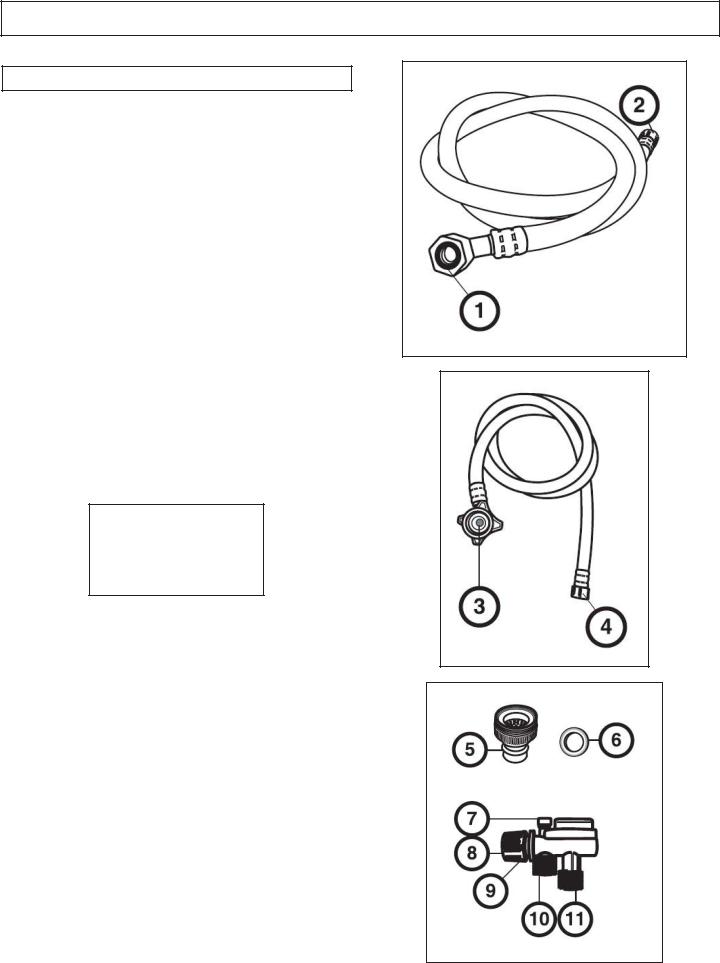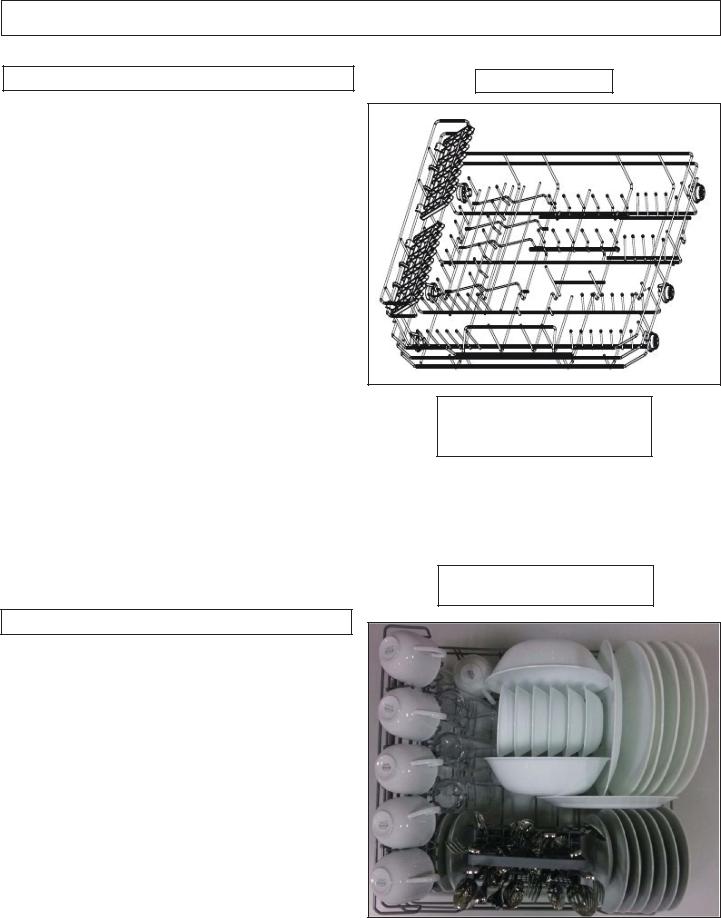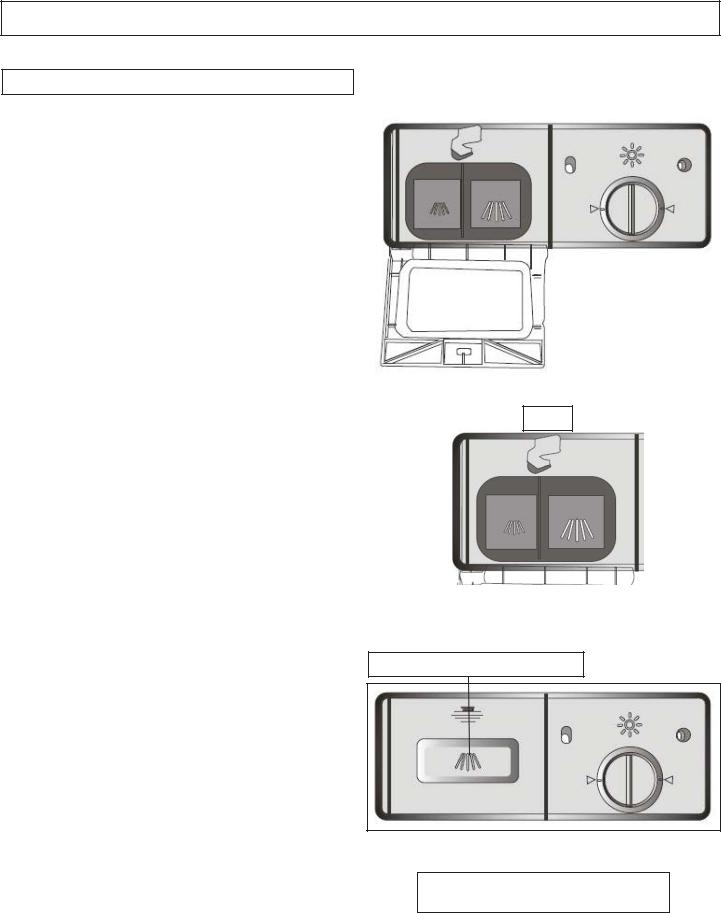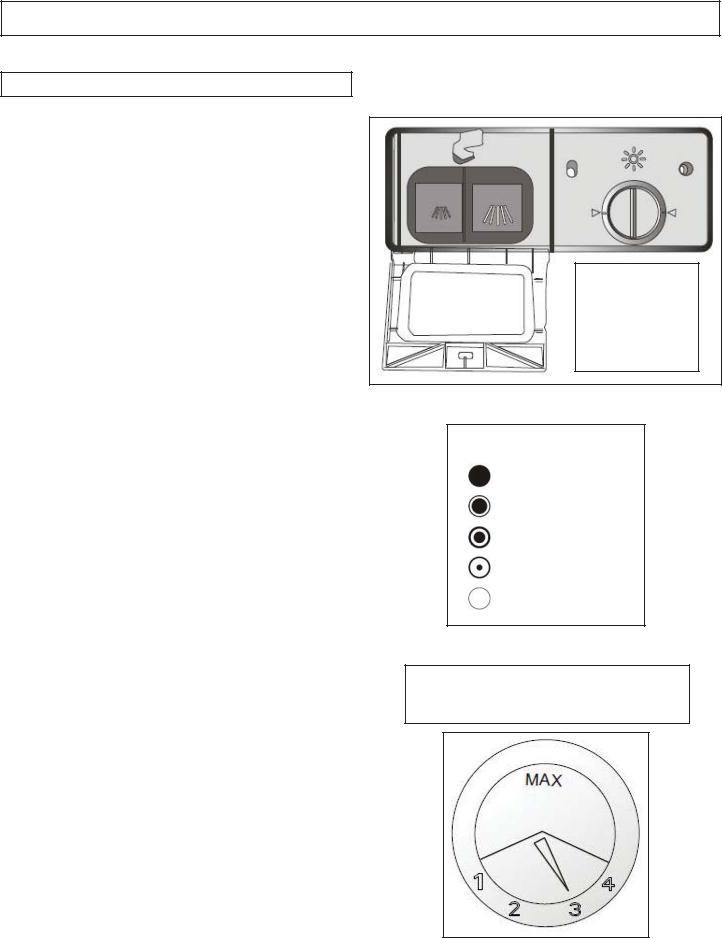Danby DDW631SDB User Manual

OWNER’S MANUAL
MANUEL DU PROPRIÉTAIRE
MANUAL DEL PROPIETARIO
MODEL • MODÈLE • MODELO
DDW631WDB
DDW631SDB
|
|
|
|
|
|
|
|
|
|
|
|
|
|
|
|
|
|
|
|
|
|
|
|
|
|
|
DISHWASHER |
|
|
|
|
|
|
|
|
|
|
|
|
|
|
|
|
|
|
|
|
|
|
|
|
|
|
Owner’s Manual............................ |
1 |
- 14 |
|
|
|
|
|
|
LAVE-VAISSELLE |
|
|
|
|
|
|
|
|
Manuel du propriétaire................ |
15 |
- 28 |
|
|
|
|
|
|
LAVAPLATOS |
|
|
|
|
|
|
|
|
Manual del propietario................ |
29 - 42 |
|
|
|
|
|
|
|
|
|
|
|
|
|
|
|
|
DANBY PRODUCTS LIMITED, ONTARIO, CANADA N1H 6Z9
DANBY PRODUCTS INC., FINDLAY, OHIO, USA 45840
2017.06.28

Welcome
Welcome to the Danby family. We are proud of our quality products and we beleive in dependable service. We suggest that you read this owner’s manual before plugging in your new appliance as it contains important operation information, safety information, troubleshooting and maintenance tips to ensure the reliability and longevity of your appliance.
Visit www.Danby.com to access self service tools, FAQs and much more. For additional assistance call 1-800-263-2629.
Note the information below; you will need this information to obtain service under warranty. You must provide the original purchase receipt to validate your warranty and receive service.
Model Number: _________________________________________________
Serial Number: _________________________________________________
Date of Purchase: _______________________________________________
Need Help?
Before you call for service, here are a few things you can do to help us serve you better.
Read this owner’s manual:
It contains instructions to help you use and maintain your appliance properly.
If you receive a damaged appliance:
Immediately contact the retailer or builder that sold you the appliance.
Save time and money:
Check the troubleshooting section at the end of this manual before calling. This section will help you solve common problems that may occur.
1-800-26- Danby (1-800-263-2629)
1

Important Safety Information
READ AND FOLLOW ALL SAFETY INSTRUCTIONS
GROUNDING INSTRUCTIONS |
|
SAFETY REQUIREMENTS |
This appliance must be grounded. In the event of an electrical short circuit, grounding reduces the risk of electrical shock by providing an escape wire for the electrical current.
This appliance is equipped with a cord that has a grounding wire and grounding plug. The power cord must be plugged into an outlet that is properly grounded. If the outlet is a 2-prong wall outlet, it
is your responsibility to have it replaced with a properly grounded 3-prong wall outlet. The serial rating plate indicates the voltage and frequency the appliance is designed for.
WARNING - Improper use of the grounding plug can result in a risk of electric shock. Consult a qualified electrician or service agent if the grounding instructions are not completely understood, or if doubt exists as to whether the appliance is properly grounded.
DO NOT USE AN EXTENSION CORD
Do not connect your appliance to extension cords or together with another appliance in the same wall outlet. Do not splice the power cord. Do not under any circumstances cut or remove the third ground prong from the power cord.
If the power supply cord is damaged, it must be replaced by the manufacturer, its service agent or similar qualified person in order to avoid hazard.
Ensure that component parts are replaced with like components and that servicing is done by factory authorized service personnel to minimize the risk of possible ignition due to incorrect parts or improper service.
This appliance is not intended for use by persons (including children) whose physical, sensory or mental capabilities may be different or reduced, or who lack experience or knowledge, unless such persons receive supervision or training to operate the appliance by a person responsible for their safety.
•Children should be supervised to ensure that they do not play with the appliance.
•Do not stand, sit or lean on the door or dish rack. Do not place heavy items on the door when it is open.
•Do not touch the heating element during or immediately after use.
•Do not operate the appliance unless all enclosure panels are properly installed.
•Open door carefully during operation, water may leak. Proceed with caution as water may be hot.
•Do not wash plastic items unless they are marked dishwasher safe.
•Use only detergent and rinse additives that are designed for an automatic dishwasher.
•Never use soap, laundry detergent or hand washing detergent in the dishwasher.
•Keep detergent and rinse aid out of the reach of children.
•Check that the detergent dispenser is empty after completion of the wash cycle.
•Dishwasher detergents are strongly alkaline and can be extremely dangerous if swallowed. Avoid contact with the skin and eyes.
•Remove the door of the appliance when removing from service or discarding.
•This appliance should be connected to the water mains using new hose sets. Old hoses should not be reused.
•The maximum permissible inlet water pressure is 1Mpa.
•The minimum permissible inlet water pressure is 0.04Mpa.
SAVE THESE INSTRUCTIONS!
2

INSTALLATION INSTRUCTIONS
CONTROL PANEL
1 |
2 |
3 |
4 |
6 |
8 |
7 |
9 |
5
13 14 15
10
11
12
1.Power Button: Press to turn the appliance on or off
2.Lock Button: Press and hold for 5 seconds to lock or unlock the buttons on the control panel
3.Delay Button: Press to delay the start of the chosen program
4.Program Indicator: Illuminates to show which program is running
5.Time Display: Shows how much time is remaining or how much time until delayed start
6.Extra Cleaning Indicator: Illuminates if extra cleaning program is chosen
7.Lock Indicator: Illuminates if control panel lock is engaged
8.Extra Drying Indicator: Illuminates if extra drying program is chosen
9.Express Indicator: Illuminates if express program is chosen
10.Rinse Aid Warning Light: Illuminates when the rinse aid dispenser is empty
11.Program Ending Indicator: Illuminates when a program has finished
12.Water Indicator: Illuminates when an issue arises with the water supply
13.Program Selector Button: Press to chose a program
14.Function Button: Press to select additional functions, extra drying, extra cleaning or express 15.Start/Pause Button: Press to begin the chosen program or to pause a program that is running
FEATURES
|
1 |
|
|
|
|
3 |
|
|
2 |
|
|
|
|
5 |
|
|
|
4 |
|
|
6 |
7 |
9 |
|
|
|
|
|
|
|
8 |
1. |
Cup Shelf |
8. |
Inlet Hose Connection |
2. |
Basket |
9. |
Drain Hose Connection |
3.Cutlery Basket
4.Filter Assembly
5.Spray Arms
6.Detergent Dispenser
7.Rinse Aid Dispenser
3

INSTALLATION INSTRUCTIONS
WATER CONNECTION
The dishwasher uses a Quick Connect assembly to connect to the water source. Ensure that all the following parts are present before beginning the connection process.
Drain Hose
1.Drain Connection
2.Quick Connect Connection
Inlet Hose
3.Inlet Connection
4.Quick Connect Connection
Only use the hoses provided with the appliance. Using longer hoses will affect the performance of the unit.
Faucet Adapter
5.Faucet Adapter
6.Faucet Washer
Quick Connect
7.Pressure Relief Valve
8.Faucet Adapter Connection
9.Locking Collar
10.Inlet Hose Connection
11.Drain Hose Connection
4

INSTALLATION INSTRUCTIONS
CONNECTING THE DISHWASHER |
|
DISCONNECTING THE DISHWASHER |
The appliance should be placed on a solid, fl at counter, near the water source.
To connect the dishwasher to the water source:
1.Remove the aerator from the faucet and screw the faucet adapter onto the faucet. The faucet adapter is compatible with both male (outside threaded) or female (inside threaded) faucets.
2.The faucet washer may or may not be necessary. Once the faucet adapter is attached to the faucet, turn on the water tap to test the connection. If there are leaks at the tap adapter connection, add the faucet washer and reattach. If there are still leaks when using the faucet washer, wrap tefl on tape around the faucet or the tap adapter and reattach.
3.Pull down the locking collar on the Quick Connect and push the end of the Quick Connect onto the end of the faucet adapter. When the Quick Connect clicks over the faucet adapter, release the locking collar.
4.Attach the water inlet hose and the drain hose to the back of the appliance. Ensure that both connections are tightened and connected to the correct ports.
5.Attach the water inlet hose and the drain hose to the Quick Connect. Ensure that the hoses are connected to the correct points on the Quick Connect. The drain hose should connect to the longer port on the Quick Connect. The inlet hose should connect to the shorter port on the Quick Connect.
6.Do not turn on the water source until you are ready to run a wash program. Once the water source is turned on, the inlet hose is pressurized and filled with water. The water is released into the unit once the wash program begins.
When the wash program is complete, turn off the water source before attempting to disconnect the appliance.
1.Press the pressure relief valve (red button) on the Quick Connect to release any remaining water from the water inlet hose.
WARNING: Failure to relieve the water pressure before disconnecting the Quick Connect from the faucet will result in pressurized water spray at the connection point. This water can be very hot and could cause burns or scalding.
2.Disconnect the inlet hose and the drain hose from the Quick Connect. Allow any water left in the hoses to drain before proceeding.
Note: For convenience, the drain hose and inlet hose can remain attached to the Quick Connect when not in use. Make sure that all water is drained from the hoses before storing.
3.Disconnect the inlet hose and the drain hose from the back of the appliance.
4.Pull down the locking collar on the Quick Connect and pull downward to remove it from the faucet adapter.
5.The faucet adapter can be removed or it can remain on the faucet as it does contain an aerator. If the faucet adapter is removed, remember to replace the aerator on the faucet.
Note: Hard water conditions will adversely affect the performace of the dishwasher. Hard water will deposit lime or white scaling onto the stainless steel surface of the dishwasher tub, the faucet aerator and the internal filter assembly. It is recommended to periodically run a rinse cycle with 1 cup (250 ml) of white vinegar while the dishwasher is empty to remove any scaling.
5

OPERATING INSTRUCTIONS
LOADING THE DISHWASHER BASKET
•Only place dishes in this appliance that are marked as dishwasher safe.
•Use a mild detergent.
Items that should not be placed in a dishwasher
•Cutlery with wooden, bone china or mother-of- pearl handles.
•Plastic items that are not heat resistant.
•Items that have been repaired with glue that is not heat resistant.
•Pewter, copper or steel items.
•Wooden platters.
•Items made from synthetic fibres.
•Items with glazed patterns may fade if machine washed frequently.
Tips for efficient loading
•Load hollow items such as cups, glasses or pans with the opening downward so that water cannot collect in the container.
•Items must not lie inside one another or cover one another.
•To avoid damage to glasses, they should not touch.
•Sharp items of cutlery such as carving knives should be loaded horizontally in the basket to avoid injury when unloading.
•Do not overload the appliance.
Dishwasher Basket
Plate racks can be stowed horizontally if large items are being loaded into the basket.
An example of a fully loaded dishwasher basket is below.
LOADING THE CUTLERY BASKET
Cutlery should be placed in the cutlery basket with the handles facing down. Ensure that cutlery items do not nest inside of one another as this can affect cleaning performance.
Sharp or pointed items should be placed in the cutlery basket with points facing down to avoid injury when unloading.
Do not place excessively small items into the dishwasher as they could fall through the basket and impact the operation of the appliance.
6

OPERATING INSTRUCTIONS
DETERGENT DISPENSER
The detergent dispenser must be filled before the start of each wash cycle. Consult the Wash Cycle Table (page 9) for specific information on the correct amount of detergent to use with each cycle.
This appliance requires less detergent and rinse aid than a conventional dishwasher. Generally, only one tablespoon of detergent will be required for a normal wash load. More heavily soiled items may require more detergent.
Always add the detergent just before starting the wash cycle. Adding the detergent to the appliance too soon can cause it to become damp and it may not dissolve properly.
If the detergent dispenser is closed, press the latch to open it.
•The left detergent compartment can hold a maximum of 15 g of detergent.
•The right detergent compartment can hold a maximum of 25 g of detergent.
Ensure that the detergent dispenser is closed before closing the door of the appliance.
|
Detergent Dispenser |
|
Rinse Aid Dispenser |
|
|
|
|
|
|
|
|
|
|
|
|
|
|
|
|
Latch
|
|
|
|
|
|
|
Left Compartment |
|
|
|
Right Compartment |
||
|
|
|
|
|
|
|
|
|
|
|
|
|
|
If the dishes are heavily soiled, additional detergent can be placed in the pre-wash detergent chamber on the outside of the lid.
Note about detergent tablets and gel packs
Detergent tablets and gel packs of different brands dissolve at different speeds. Some detergent tablets or gel packs cannot dissolve and develop their full cleaning power in a compact dishwasher.
For this reason, it is not recommended to use detergent tablets or gel packs with this appliance.
Pre-Wash Detergent Chamber
Dishwasher detergent is corrosive. Keep out of reach of children.
7

OPERATING INSTRUCTIONS
RINSE AID DISPENSER
Detergent Dispenser |
|
Rinse Aid Dispenser |
|
|
|
Rinse aid can be used to prevent water droplets or streaks from forming on dishes. The rinse aid will be released automatically during the final rinse.
The rinse aid dispenser is located inside the door, next to the detergent dispenser. To fill the rinse aid dispenser, open the cap and pour rinse aid into the dispenser until the level indicator on the right turns black. Be careful not to overfull the dispenser. The total volume of the rinse aid dispenser is 110 ml.
Do not put any other substance in the rinse aid dispenser as this can damage the appliance.
As the rinse aid diminishes, the size of the black dot on the rinse aid level indicator will change. Once the black dot has become clear, the rinse aid dispenser should be refilled.
Twist cap to the left and pull out to remove.
Make sure to replace the cap after filling.
Rinse Aid Indicator
Full
3/4 full
1/2 full
1/4 full
Empty
The rinse aid dispenser has four settings. The recommended setting is “3”.
If dishes are not drying properly or if water spots are forming, turn the setting to “4”.
If there is a sticky residue on dishes after washing, turn the setting to “1” or “2”.
Adjust the amount of rinse aid that will be dispensed by changing the setting on the knob inside the dispenser.
8

OPERATING INSTRUCTIONS
WASH CYCLE TABLE Press the program button to select the desired wash program.
Program |
Cycle Description |
Cycle Breakdown |
Detergent |
Running Time |
Energy Use |
Water Use |
|||||||
|
|
|
|
|
|
|
|
|
|
|
|
|
|
Heavy |
For heavily soiled |
Pre-Wash |
18 grams |
100 minutes |
0.49 kWh |
12.5 litres |
|||||||
|
|
|
|
|
|
|
|
loads such as pots |
Pre-Wash (50°C) |
|
|
|
|
|
|
|
|
|
|
|
|
and pans |
Wash (55°C) |
|
|
|
|
|
|
|
|
|
|
|
|
|
Wash (50°C) |
|
|
|
|
|
|
|
|
|
|
|
|
|
Rinse |
|
|
|
|
|
|
|
|
|
|
|
|
|
|
|
|
|
|
|
|
|
|
|
|
|
|
|
Rinse (68°C) |
|
|
|
|
|
|
|
|
|
|
|
|
|
|
|
|
|
|
Normal |
For normally |
Pre-Wash |
18 grams |
110 minutes |
0.36 kWh |
10.8 litres |
|||||||
|
|
|
|
|
|
|
|
soiled loads; |
Pre-Wash |
|
|
|
|
|
|
|
|
|
|
|
|
standard daily |
Wash (52°C) |
|
|
|
|
|
|
|
|
|
|
|
|
cycle |
Rinse |
|
|
|
|
|
|
|
|
|
|
|
|
|
Rinse (65°C) |
|
|
|
|
|
|
|
|
|
|
|
|
|
|
|
|
|
|
|
|
|
|
|
|
|
|
|
|
|
|
|
|
Baby Care |
For lightly soiled |
Pre-Wash |
18 grams |
90 minutes |
0.51 kWh |
12.5 litres |
|||||||
|
|
|
|
|
|
|
|
loads |
Pre-Wash (50°C) |
|
|
|
|
|
|
|
|
|
|
|
|
|
Wash (55°C) |
|
|
|
|
|
|
|
|
|
|
|
|
|
Rinse |
|
|
|
|
|
|
|
|
|
|
|
|
|
Rinse |
|
|
|
|
|
|
|
|
|
|
|
|
|
Rinse (70°C) |
|
|
|
|
|
|
|
|
|
|
|
|
|
|
|
|
|
|
|
|
|
|
|
|
|
|
|
|
|
|
|
|
ECO |
Energy conserving |
Pre-Wash |
18 grams |
75 minutes |
0.27 kWh |
10 litres |
|||||||
|
|
|
|
|
|
|
|
cycle for lightly |
Pre-Wash (50°C) |
|
|
|
|
|
|
|
|
|
|
|
|
soiled loads |
Wash (50°C) |
|
|
|
|
|
|
|
|
|
|
|
|
|
Rinse |
|
|
|
|
|
|
|
|
|
|
|
|
|
Rinse (60°C) |
|
|
|
|
|
|
|
|
|
|
|
|
|
|
|
|
|
|
|
|
|
|
|
|
|
|
|
|
|
|
|
|
Glass |
For lightly soiled |
Pre-Wash |
15 grams |
70 minutes |
0.28 kWh |
8.5 litres |
|||||||
|
|
|
|
|
|
|
|
glassware |
Wash (50°C) |
|
|
|
|
|
|
|
|
|
|
|
|
|
|
|
|
||
|
|
|
|
|
|
|
|
|
Rinse |
|
|
|
|
|
|
|
|
|
|
|
|
|
Rinse (60°C) |
|
|
|
|
|
|
|
|
|
|
|
|
|
|
|
|
|
|
|
|
|
|
|
|
|
|
|
|
|
|
|
|
Speed |
A fast cycle for |
Pre-wash |
15 grams |
45 minutes |
0.31 kWh |
10.5 litres |
|||||||
|
|
|
|
|
|
|
|
lightly soiled loads |
Pre-wash (50°C) |
|
|
|
|
|
|
|
|
|
|
|
|
|
|
|
|
||
|
|
|
|
|
|
|
|
|
Wash (50°C) |
|
|
|
|
|
|
|
|
|
|
|
|
|
Rinse |
|
|
|
|
|
|
|
|
|
|
|
|
|
Rinse (55°C) |
|
|
|
|
|
|
|
|
|
|
|
|
|
|
|
|
|
|
Rinse |
Rinse cycle only |
Pre-Wash |
N/A |
24 minutes |
0.03 kWh |
4.3 litres |
|||||||
|
|
|
|
|
|
|
|
|
Rinse |
|
|
|
|
|
|
|
|
|
|
|
|
|
|
|
|
|
|
|
|
|
|
|
|
|
|
|
|
|
|
|
|
|
|
|
|
|
|
|
|
|
|
|
|
|
|
Mini-Party |
For lightly soiled |
Wash (45°C) |
15 grams |
20 minutes |
0.18 kWh |
6.5 litres |
|||||||
|
|
|
|
|
|
|
|
loads |
Rinse |
|
|
|
|
|
|
|
|
|
|
|
|
|
|
|
|
||
|
|
|
|
|
|
|
|
|
Rinse (50°C) |
|
|
|
|
|
|
|
|
|
|
|
|
|
|
|
|
|
|
9

OPERATING INSTRUCTIONS
STARTING A WASH CYCLE |
|
ENDING A WASH CYCLE |
1.Load the dishwasher as per the loading instructions.
2.Add detergent and rinse aid as required.
3.Ensure the dishwasher is connected to a water supply and that the water is turned on.
4.Insert the plug into the power supply.
5.Close the dishwasher door and press the power button to turn on the appliance.
6.Press the Program button repeatedly to choose the desired wash program. The programs will cycle in the following order: Heavy -> Normal -> Baby Care -> ECO -> Glass -> Speed -> Rinse -> Mini-Party
7.Press the Start/Pause button to begin the cycle.
ADDING A FORGOTTEN DISH
A forgotten dish can be added to a running cycle any time before the detergent dispenser has opened. If the detergent has already been released into the appliance, it is recommended not to add more dishes as they will not receive adequate cleaning.
To add a dish:
1.Press the Start/Pause button to pause the cycle.
2.Open the door slowly as the spray arm may still be turning.
3.Add the forgotten dishes.
4.Close the door.
5.Press the Start/Pause button to resume the cycle. The appliance can take up to 10 seconds to restart.
When a wash cycle is completed, a buzzer will sound for 8 seconds, then stop. The appliance will automatically turn off after 30 minutes of inactivity.
To turn off and unload the dishwasher:
1.Press the power button to turn the appliance off.
2.Turn off the water supply and unplug the appliance from the power source.
3.Allow the appliance to remain undisturbed with the door closed for approximately 5-10 minutes at the end of a cycle. Opening the door too quickly while the internal temperature is still very hot can cause fl ash drying which can leave spots and streaks on dishes.
4.Open the door carefully as the air inside the appliance can still be hot. Leave the door ajar for a few minutes before removing dishes to allow them to cool and dry. Hot dishes can be sensitive to knocks and may break; they should be allowed to cool before removing from the appliance.
Note: There is no drying cycle in this appliance. Dishes should be left inside the unit for a short period after a cycle so that the warm air inside the appliance can assist in the drying process. It is normal for dishes to still be wet at the end of a cycle.
Note: It is normal for a small amount of water to remain inside the appliance at the end of a cycle. This water will evaporate and does not need to be manually drained.
10

CARE & MAINTENANCE
FILTER SYSTEM
The filter system removes food particles from the wash water and traps them. It is highly
recommended to empty and clean the filters after every wash cycle.
There are three parts to the filter system:
1.Coarse filter: This filter traps larger items such as pieces of bone or glass that could block the drain.
To clean this filter, squeeze the top and lift it out of the assembly. Discard any items in this filter and then rinse with warm water.
2.Fine filter: This filter traps food particles and residue and prevents it from being re-deposited on the dishes during the rinse cycle.
To clean this filter, grip the top and pull it out of the assembly. Discard any items in this filter and then rinse with warm water.
3.Main filter: This filter holds the smallest food particles.
It is not necessary to manually clean this filter as particles trapped by this filter are pulverized by a special jet on the spray arm and are washed down the drain.
Note: All three pieces of the filter may come out of the unit in one piece and can be difficult to seperate. It is still possible to rinse and clean the filters as one piece and then replace inside the appliance.
SPRAY ARM
The spray arm can be removed from the appliance by pulling gently upwards. Rinse the spray arm with warm water to remove any debris that can clog the nozzles. Replace the spray arm in the appliance by pushing downward until it clicks into place. Ensure that the spray arm movement is not impeded before running another cycle.
1
2
3
11

CARE & MAINTENANCE
CLEANING |
|
ERROR CODES |
•Unplug the appliance from the power source before completing any cleaning or maintenance.
•After every wash, turn off the water supply and leave the door slightly open so that moisture and odors are not trapped inside the appliance.
•Only use a soft cloth and mild detergent to clean the appliance. Never use solvents or abrasive cleaning agents as this can damage the appliance.
•To remove water spots from the interior of the appliance, use a soft cloth dampened with a small amount of vinegar.
•If the appliance will not be used for a long period of time, it is recommended to run a normal wash cycle with the dishwasher empty and then leave the door open until the interior of the appliance is completely dry. This will help the door seals last longer and will help prevent odors from forming inside the appliance.
•Clean the door seals with a damp sponge regularly to prevent odors from food particles that can become trapped in the door seal.
E1: Not enough water getting into the unit
•The water source is not turned on
•Water intake is restricted
•Water pressure is too low
E3: Not reaching correct temperature
• Malfunction of heating element
E4: Water overfl ow
•Drain malfunction
•Drain clog
Ed: Control board malfunction
• Internal communication error
If the appliance displays any error code, a power reset may resolve the issue. Unplug the appliance, wait approximately 5 minutes and then plug the unit back in.
12

TROUBLESHOOTING
Danby Consumer Care: 1-800-263-2629
Hours of operation:
Monday to Thursday 8:30 am - 6:00 pm Eastern Standard Time
Friday 8:30 am - 4:00 pm Eastern Standard Time
Information in this manual is subject to change without notice.
PROBLEM |
|
POSSIBLE CAUSE |
No power |
• |
A fuse may be blown or the circuit breaker tripped |
|
• |
Power surge |
|
• Plug not fully inserted into the wall outlet |
|
|
• Door not closed correctly |
|
Water not drained from dishwasher |
• |
Kink in drain hose |
|
• |
Filter clogged |
|
• |
Drain pump malfunction |
Detergent left in the dispenser |
• |
Dishes blocking dispenser from fully opening; unit may be |
|
|
over loaded |
Suds left in the appliance |
• |
Too much detergent or wrong kind of detergent |
|
• Too much rinse aid |
|
White film or cloudiness on dishes or |
• |
Hard water minerals |
interior tub |
• |
Too much detergent |
|
||
|
• Not enough rinse aid |
|
Noise inside the tub while running |
• |
The spray arm is hitting an item in the basket |
|
• An item has fallen out of the basket and is on the bottom of |
|
|
|
the wash tub |
Dishes are not clean |
• |
Dishes were loaded incorrectly |
|
• The wash program was not powerful enough |
|
|
• |
Not enough detergent |
|
• Items are blocking the spray arm; unit may be over loaded |
|
|
• |
Filter clogged |
Dishes are not drying |
• |
Dishes were loaded incorrectly |
|
• Too many dishes were loaded |
|
|
• Not enough rinse aid |
|
|
• Dishes removed too quickly |
|
13
